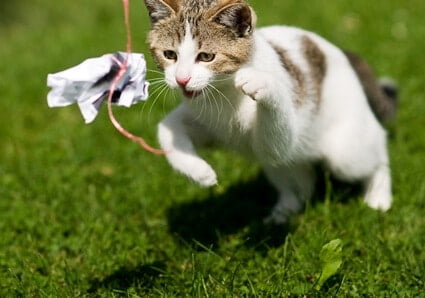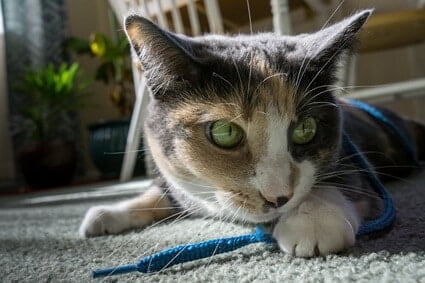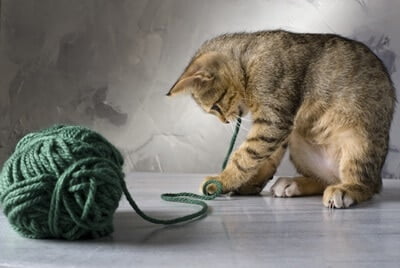Cats are often fascinated by the prospect of chasing, attacking, and playing with string. It is often regarded as the ultimate DIY cat toy. Toss a ball of wool or yarn to a cat, and your pet will likely be entertained for hours.
Feline vision revolves around sudden movement, so a dangling piece of string will immediately grab the cat’s attention. Toys attached to string will also sate a cat’s hunting desires, as they provide a moving prey-like target to stalk and pounce upon.
Although cats love to play with string, they cannot do so unattended. String will keep cats entertained, but it can be dangerous. Always supervise a cat playing with string, and ensure that you are using this material safely.
Why Do Cats Go Crazy for String?
Cats love to chase, bite and attack string. This is not restricted to yarn, either. Everyday items, such as shoelaces, sewing thread, and ribbons, will often attract a cat’s attention.
As explained by Animal Cognition, this is not because cats recognize the purpose of string. Throughout an experiment, scientists discovered that cats lack cognitive understanding of the essential motor functions of string.
Many pet owners find themselves asking, “why do cats attack string?” or “why do cats chase string?” As is so often the case when assessing feline behavior, the answer lies within the realm of instinct. Much of the time, playing with string satisfies a cat’s need to hunt.
Hunting Games
Cats are born hunters. While it is unwise to curb this instinct, hunting birds and other wildlife can negatively impact the natural world.
As a result, owners should play with their cats to sate this desire to hunt. The Journal of Veterinary Behavior confirms that regular play reduces the likelihood of problem behaviors.
String comes into this when we consider cat toys. Most popular games played between owners and cats involve stalking and pouncing. This may be a wind-up toy, a laser pointer, or commonly a target found on the end of a stick.
Cats love to pounce on toys, the same way they would live prey. If an owner is holding a toy at this point, scratching and biting will invariably follow. As a result, many such cat toys are attached to a long string. As feline vision revolves around movement, a dangling string will also gain immediate attention.
Dangling a toy in string ticks multiple boxes in owner-cat play. It keeps you safe while giving your cat a target to stalk. String also means that you can yank a toy from your cat’s clutches at the eleventh hour.
This is not an act of cruelty – it’s vital to the game. Hunting cats actively seek a challenge. If they capture prey at the first time of asking, they quickly grow bored of play. By making a cat work to ‘win’ and earn a reward, playtime is extended to an ideal length.
Capturing Prey
This capture of prey is possibly the most critical part of all cat play. As discussed, cats like a contest when hunting, Stationery prey that does not try to escape is no fun. Equally though, a cat that never ‘wins’ a game will grow frustrated.
This can happen with older cats in particular. Some breeds of cats are born mousers and will regularly eliminate a rodent presence from home. As a cat grows older and slows down, though, they may find hunting more and more difficult.
Eventually, if a cat regularly fails to catch a mouse, it will stop trying. The same applies to hunting games. Laser pointers are popular toys as they constantly offer something to chase. Ask yourself, though – what is the endgame for a cat?
If hunting toys are designed to sate the feline hunting instinct, there must be an end product. Namely, the cat needs to grip a tangible reward. This way, the cat feels that it has completed a hunt.
Stringed toys provide this – and, as mentioned above, protect an owner from any teeth and claws in the process. Allowing a cat to successfully ‘win’ one game in every three or four castings of a stringed toy will provide the ideal balance between effort and victory.
Sense of Discovery
Cats are curious and love to discover new things. This can apply to string. By constantly unraveling a ball of string, a cat will learn how much material it contains. This behavior is similar to when cats chase, shred and separate toilet rolls.
Such a playstyle can also be tied to hunting instinct. When a cat unravels the toilet roll, it eventually reaches a cardboard tube. This is the cat’s prize for its persistence in the hunt. Your pet will be looking for a similar result from balled string.
Appealing to this sense of curiosity is harmless as long as the cat stays safe. Always watch a cat that unravels a ball of string carefully, though. Your pet could get itself into trouble before long.
Resemblance to Prey
In some cases, string excites cats because they mistake it for prey. A piece of dangling string could easily be confused with the tail of a rodent, for example. This will inspire a cat to attack the string.
Some commentators even believe that cats stalk string as it looks like a snake. While the Journal of Herpetology confirms that some cats hunt and eat snakes, this is rare in pets.
Feral cats may attack snakes as they are competing for food. Based on their reaction to cucumbers, housecats are likelier to flee. Remain mindful, all the same. If your cat is happy to hunt a snake, it will quickly see red and seek to stalk the string – and possibly eat it.

Importance to Humans
Never underestimate the value that cats attribute to items that humans use. Any time you spend on hobbies or essential activities is time not spent with a cat. If your pet wants your attention, it may remove any competition.
Wool and yarn are possibly the best examples of this. A cat will watch somebody knitting with a great deal of fascination. The concentration and calm that the activity seems to require will not go unnoticed either involved. They make the product irresistible to a cat.
The same could even be attributed to more perfunctory string, such as shoelaces. If your cat is prone to separation anxiety, it will do what it can to stop you from leaving the house. If the cat spots you tying shoes, it may attack laces on your footwear.
Is it Safe for Cats to Play with String?
We have established that cats love to play with string. This does not mean that cats should play with string, though. Despite being governed by survival instinct, our pets indulge in many questionable, dangerous habits.
String has many risks to cats. The first, as unlikely as it may sound, is strangulation. A cat may find itself tangled up in string and cut off the air supply. Our popular example of chasing a ball of yarn is the likeliest to result in this concern.
Another problem with cats playing with string is the temptation to eat it. We will discuss why cats eat string in more detail in one moment. Rest assured, though, whatever the explanation for the behavior, chewing or swallowing string should never be permitted.
Consider the secondary impact of a cat playing with string. Your pet may trip over string, ribbon, or laces, leading to strains or even broken bones. All of these reasons ensure that, as popular as string is with cats, it must never be a free-play toy.
What Kind of String is Safe for Cats?
The short answer is that no string is really safe for cats. String may be a part of your cat’s life and play routines, but it should never be the focal point. String-centric toys are fine and even recommended, but only when played with under supervision.
Never toss a cat a piece of string or ribbon to play with. Such action will indeed provide you with a bit of peace and quiet in the short term. The potential for disastrous consequences remains great and must be taken under advisement.
The one exception to this is an edible string. Pull ‘n Play from Friskies is an example of this. Cats can turn a treat into a game with edible string, tugging the snack from its plastic home and tucking in.
On the one hand, this is a great idea. It keeps your cat content and ensures that it needs to work for a treat rather than simply demanding it. Be mindful of the precedent that you’ll be setting, though. This could send a message that all string is a fair game for eating.
Alternatives to String for Cats
As above, it’s best to avoid providing cats with a like-for-like replacement for string. To avoid any confusion, ensure that your cat understands that string is not to be used unattended. There are other ways to keep your pet happy without string.
One solution is to give your cat something else to hunt and chase. Consider toys that move of their own accord, such as clockwork mice. Remember that a cat needs something tangible to stalk. Failing to provide this can see a cat pounce on your ankles instead.
If you do not mind cleaning up after your cat, toss it a toilet roll. This will provide the same entertainment as a ball of wool. Your cat can unravel the roll, and if it decides to consume the paper, no harm will come to your pet.
Equally, if your cat likes to chew string, give it something else to claim for chewing. A tough, non-toxic artificial houseplant may do the trick. Better yet, determine why your cat feels so compelled to chew. There may be an underlying concern that you must address.
Why Do Cats Like to Eat String?
Playing with string is one thing. Completed under supervision, with the string part of a toy rather than the focus, it can be acceptable. Eating string is another matter entirely.
Cats must never be allowed to eat string. String can wrap itself around the intestines, leading to an intestinal blockage. As per the Journal of Small Animal Practice, this can be fatal in up to 50% of felines.
If eating string is so dangerous, though, why do cats do it? It may be an accident. Most cats like to chew string, and swallowing can be an unintentional side effect. All the same, it remains critical to understand why a cat may be looking to chew – and eat – string.
Instinct
We have discussed how many cats enjoy playing with string-based toys. Doing so stimulates the instincts linked to a hunt, leaving the cat feeling like it successfully captured prey. If a cat likes to conclude a quest for quarry with eating, this can be dangerous.
Not all cats eat their prey. In fact, the behavior could be called comparatively rare. For many cats, hunting is for sport, not nourishment. Some felines have more voracious appetites than others, though. Equally, a cat may be curious about the taste of its ‘kill.’
In these instances, a cat is likely to eat string. This may be wool, having been unraveled across the floor of a room. Alternatively, it may be the stirring attached to a toy. The cat has identified the weakest point of its victim, just as it would snap the neck of a mouse or bird.

Physical or Emotional Stress Relief
Chewing behavior is firmly ingrained in cats. Many cats will chew to pass the time, though the behavior is commonly linked to stress. Cats will chew to self-soothe in the face of anxiety or distress.
In many instances, string is also fun for cats to chew. Wool or yarn, in particular, will have a taste that appeals to cats. The texture of the material will remind a cat of the clothing that you wear.
Chewing will also distract a cat from any physical pain. Toothache is the one exception to this. Cats do not floss their teeth and will not start by using string. In the event of oral discomfort, a cat will not allow anything into its mouth.
Look out for other signs of pain, such as limping or reluctance to be held. Uncharacteristic chewing of string could be a subtle sign that all is not right with your pet.
Pica
If your cat’s chewing of string becomes compulsive eating of the material, your pet may have pica. Pica is a form of OCD that leaves cats compelled to eat inappropriate household items.
As per the Journal of Feline Medicine and Surgery, string – especially shoelaces or thread – are the most common items targeted by a cat with pica. If your cat is struck down with this condition, professional help to determine why is essential.
Pica is not a condition in and of itself. Instead, it is a symptom connected to an underlying cause. Some of these explanations could include:
- Issues with the diet (often a deficiency of specific vitamins or nutrients)
- Stress and anxiety
- Lack of stimulation in the home environment
- Overactive thyroid gland (aka hyperthyroidism)
Never let pica run its course, hoping that your cat will grow out of the phase. It may swallow something hazardous, including string before this happens. Take the necessary actions to treat your cat’s pica.
How to Stop Cats from Eating String
Avoidance is the only real way to prevent a cat from eating string. Keep anything that a cat could potentially swallow out of reach. If you’re playing with string-centric toys, keep these in a secure location when not in direct use.
You should also deter your cat from chewing on anything that could be considered string adjacent. Take electrical cables, for example. It stands to reason that you do not want your cat chewing on these anyway. They may appeal for the same reasons as string, though.
Keep your cat away from anything that could resemble string using scents and sounds. Cats loathe the aroma of citrus, so squirt this over any cables or materials. A loud noise (such as clapping your hands) also creates negative connotations to string when a cat approaches.
The latter approach, while it must be used sparingly, is always practical. Do not expose your cat to a constant cacophony of noise. That will lead to anxiety. To create an unwelcome association between string and sound, though. This will be helpful in the long term.
String is a never-ending source of fascination for cats. Alas, that does not mean that it’s a safe household item to double up as a toy. While string-centric toys can delight your cat and strengthen your bond through play, remain vigilant about keeping string out of your cat’s paws when unattended.

